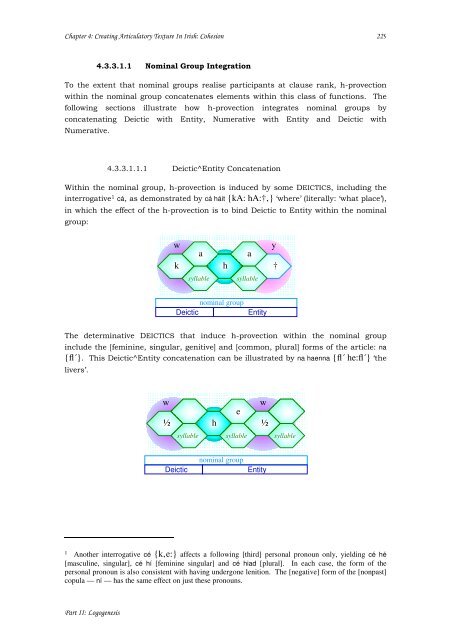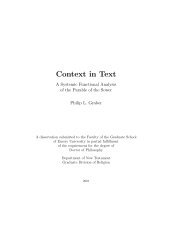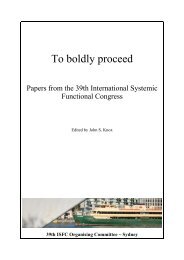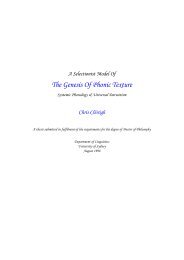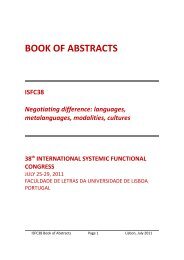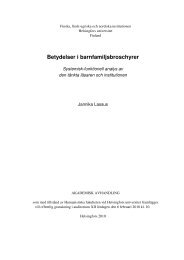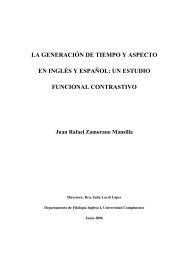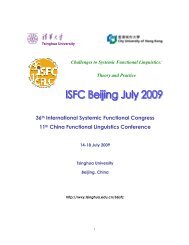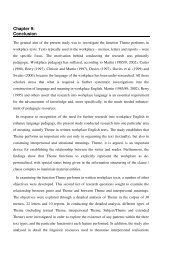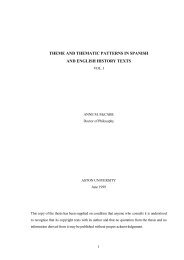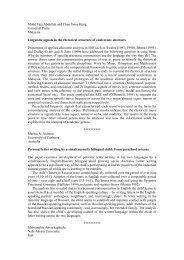part 3 - International Systemic-Functional Linguistics Association
part 3 - International Systemic-Functional Linguistics Association
part 3 - International Systemic-Functional Linguistics Association
You also want an ePaper? Increase the reach of your titles
YUMPU automatically turns print PDFs into web optimized ePapers that Google loves.
Chapter 4: Creating Articulatory Texture In Irish: Cohesion<br />
229<br />
4.3.3.1.1 Nominal Group Integration<br />
To the extent that nominal groups realise <strong>part</strong>icipants at clause rank, h-provection<br />
within the nominal group concatenates elements within this class of functions. The<br />
following sections illustrate how h-provection integrates nominal groups by<br />
concatenating Deictic with Entity, Numerative with Entity and Deictic with<br />
Numerative.<br />
4.3.3.1.1.1 Deictic^Entity Concatenation<br />
Within the nominal group, h-provection is induced by some DEICTICS, including the<br />
interrogative 1 cá, as demonstrated by cá háit {kA: hA:†‚} ‘where’ (literally: ‘what place’),<br />
in which the effect of the h-provection is to bind Deictic to Entity within the nominal<br />
group:<br />
w<br />
k<br />
a<br />
h<br />
a<br />
y<br />
†<br />
syllable<br />
syllable<br />
nominal group<br />
Deictic<br />
Entity<br />
The determinative DEICTICS that induce h-provection within the nominal group<br />
include the [feminine, singular, genitive] and [common, plural] forms of the article: na<br />
{fl´}. This Deictic^Entity concatenation can be illustrated by na haenna {fl´ he:fl´} ‘the<br />
livers’.<br />
w<br />
½<br />
Ø<br />
h<br />
e<br />
w<br />
½<br />
Ø<br />
syllable<br />
syllable<br />
syllable<br />
Deictic<br />
nominal group<br />
Entity<br />
1<br />
Another interrogative cé {k‚e:} affects a following [third] personal pronoun only, yielding cé hé<br />
[masculine, singular], cé hí [feminine singular] and cé hiad [plural]. In each case, the form of the<br />
personal pronoun is also consistent with having undergone lenition. The [negative] form of the [nonpast]<br />
copula — ní — has the same effect on just these pronouns.<br />
Part II: Logogenesis
Chapter 4: Creating Articulatory Texture In Irish: Cohesion<br />
230<br />
Another DEICTIC that induces h-provection within the nominal group is the [third,<br />
feminine, singular] possessive determinative a {´}. 1 This Deictic^Entity concatenation<br />
can be illustrated by a haois {´ hi:S} ‘her age’.<br />
Ø<br />
syllable<br />
h<br />
i<br />
s<br />
syllable<br />
y<br />
nominal group<br />
Deictic<br />
Entity<br />
When dhá intervenes between this Deictic and a following noun functioning as Entity<br />
within the nominal group, h-provection is delayed until the noun (just as eclipsis is<br />
delayed when dhá intervenes between the eclipsing [third, plural] possessive and a<br />
following noun). This is illustrated below by a dhá hiníon {´ VA: hin‚i:n} ‘her two<br />
daughters’, where h-provection binds Numerative and Entity within the nominal<br />
group:<br />
Ø<br />
syllable<br />
– w<br />
a<br />
Ž<br />
syllable<br />
h<br />
I<br />
syllable<br />
y<br />
n<br />
w<br />
i n<br />
syllable<br />
Deictic<br />
nominal group<br />
Numerative<br />
Entity<br />
4.3.3.1.1.2 Numerative^Entity Concatenation<br />
The Numeratives that induce h-provection within the nominal group are the<br />
ordinatives other than chéad ‘first’. 2 This is illustrated below by an dara háit {´[n] ∂A\´<br />
hA:†‚} ‘(the) second place’, where h-provection binds Numerative and Entity within<br />
the nominal group:<br />
1<br />
A reconstructed earlier form of this h-provector was s-final *esija:s (Pedersen and Lewis 1961: 216).<br />
2<br />
The quantifying Numeratives trí ceithre cúig sé (3-6) prefix /h/ to uaire ‘times’ (CB: 24).<br />
Part II: Logogenesis
Chapter 4: Creating Articulatory Texture In Irish: Cohesion<br />
231<br />
4.3.3.1.1.3 Deictic^Numerative Concatenation<br />
The definite article functioning as Deictic induces h-provection within the nominal<br />
group when a Numerative intervenes before the following noun functioning as Entity.<br />
This is illustrated by beir leat na hocht gcinn {´ VA: hin‚i:n} ‘bring (with-2sg) the eight ofthem’,<br />
where h-provection binds Deictic and Numerative within the nominal group<br />
(functioning as Medium):<br />
4.3.3.1.2 Prepositional Phrase Integration<br />
To the extent that prepositional phrases realise circumstances at clause rank,<br />
h-provection within the prepositional phrase concatenates elements within the<br />
syntagmatic extension of this class of functions.<br />
The integration of prepositional<br />
phrase structure by means of h-provection involves the concatenation of Process and<br />
Range.<br />
Within the prepositional phrase, the prepositions go ‘to’ and le ‘with’ induce<br />
h-provection. For example, in go hÉirinn {g´ he: \‚ëfl‚} ‘to Ireland’, h-provection<br />
concatenates the preposition go functioning as (minor) Process with the noun Éirinn<br />
functioning as Range, signalling that the two words are functioning within the same<br />
lexicogrammatical unit. 1 This is illustrated below.<br />
1<br />
In tá tú go hálainn ‘you are beautiful’ (literally: ‘are 2sg “to” beautiful’; cf English ‘to the good’), h-<br />
provection concatenates the preposition go functioning as (minor) Process with the adjective álainn<br />
functioning as Range, signalling that the two words are functioning within the same lexicogrammatical<br />
unit: a prepositional phrase functioning as circumstantial Attribute at clause rank. This is represented<br />
below.<br />
Part II: Logogenesis
Chapter 4: Creating Articulatory Texture In Irish: Cohesion<br />
232<br />
w<br />
g<br />
Ø<br />
h<br />
e<br />
y<br />
\<br />
Ø<br />
y<br />
½<br />
syllable<br />
syllable<br />
syllable<br />
Process<br />
prepositional phrase<br />
Range<br />
4.3.3.1.3 Verbal Group Integration<br />
To the extent that verbal groups realise processes at clause rank, h-provection within<br />
the verbal group concatenates elements within the syntagmatic extension of this<br />
function. Within the verbal group, h-provection is only induced by the [negative]<br />
POLARITY — ná {flA:} — that precedes verbs of [imperative] MOOD. This is illustrated<br />
below for ná himigh {flA: him‚i:} ‘don’t leave’ where h-provection concatenates the<br />
[negative] POLARITY ná with the verb imigh functioning as Event, signalling that the two<br />
words are functioning within the same lexicogrammatical unit:<br />
w<br />
a<br />
w<br />
u<br />
w<br />
† † g<br />
syllable syllable<br />
Ø<br />
syllable<br />
h<br />
a<br />
syllable<br />
w<br />
l<br />
Ø<br />
syllable<br />
y<br />
½<br />
Process<br />
Carrier<br />
Process<br />
Attribute: circumstantial<br />
Range<br />
Part II: Logogenesis
Chapter 4: Creating Articulatory Texture In Irish: Cohesion<br />
233<br />
4.3.3.2 t-Provection<br />
The Modern Irish definite article an, functioning as Deictic in nominal groups, prefixes<br />
/t/ to some vowel-initial and /s/-initial 1 words, provided that the article is not preceded<br />
by — or fused with — a preposition. The history of this process would seem to be that<br />
the t-provection article has evolved from Proto-Celtic *sindos~sindas which became *ind-h<br />
through lenition, and then int before vowels and lenited /s/ — {h} — in some case<br />
forms of Old Irish (Thurneysen 1980: 132). 2<br />
This following discussion briefly illustrates how t-provection functions to integrate<br />
nominal groups by concatenating elements within their function structure, namely:<br />
Deictic with Entity, and Deictic with Numerative. To the extent that nominal groups<br />
realise <strong>part</strong>icipants at clause rank, t-provection within the nominal group<br />
concatenates these elements within this class of functions.<br />
4.3.3.2.1 Deictic^Entity Concatenation<br />
The article functioning as Deictic prefixes /†/ to an immediately following vowel-initial<br />
[masculine] noun, or an /s/-initial [feminine, singular, common] or [masculine,<br />
singular, genitive] noun functioning as Entity in a nominal group. This process can<br />
be illustrated by an t-ainm {´[n] †an‚ ë m‚} ‘the name’, where /†/ is prefixed to the<br />
[masculine] noun ainm, and by an tsúil {´[n] †u:l‚} ‘the eye’, where /†/ is prefixed to the<br />
[feminine, singular, common] noun súil. In each case, the function of the t-provection<br />
is to bind together the Deictic and Entity within the nominal group. These examples<br />
are represented below.<br />
Ø n<br />
syllable<br />
w<br />
†<br />
A<br />
n<br />
syllable<br />
y<br />
m<br />
Ø n<br />
syllable<br />
w<br />
u l<br />
†<br />
syllable<br />
y<br />
nominal group<br />
Deictic<br />
Entity<br />
nominal group<br />
Deictic<br />
Entity<br />
This process can be further illustrated by ceol an tsrutháin {k‚o:l ´[n] †\øha:n‚} ‘music of<br />
the stream’ (literally: ‘music the stream-[genitive]’), where /†/ is prefixed to the<br />
[masculine, singular, genitive] noun srutháin. In this case, the function of the t-<br />
provection is to bind together the Deictic and Entity within the embedded nominal<br />
group functioning as Qualifier of the ranking nominal group. This example is<br />
represented below.<br />
1<br />
This only affects Onset (Head) /s/ — (proclitic) Outset /s/ is not affected.<br />
2<br />
See Thurneysen (1980: 293-299) for the details.<br />
Part II: Logogenesis
Chapter 4: Creating Articulatory Texture In Irish: Cohesion<br />
234<br />
y<br />
k<br />
o<br />
l<br />
syllable<br />
w<br />
Ø n<br />
syllable<br />
w<br />
† \<br />
I<br />
syllable<br />
w<br />
h<br />
a n<br />
syllable<br />
y<br />
Entity<br />
nominal group<br />
Qualifier<br />
Deictic<br />
Entity<br />
4.3.3.2.2 Deictic^Numerative Concatenation<br />
The article functioning as Deictic also prefixes /†/ to an immediately following vowelinitial<br />
Numerative. This can be illustrated by an t-ocht gcat {´[n] †ox† ga†} ‘the eight<br />
cats’, the function of the t-provection is to bind together the Deictic and Numerative<br />
within the nominal group:<br />
Ø n<br />
syllable<br />
w w w<br />
E + A<br />
† x † k †<br />
syllable<br />
syllable<br />
Deictic<br />
nominal group<br />
Numerative<br />
Entity<br />
4.4 Summary<br />
This chapter has used the model of phonogenesis developed in previous chapters to<br />
describe the cohesive resources that contribute to the creation of articulatory texture<br />
in Irish. The discussion can be summarised as follows.<br />
The discussion of articulatory potential constrained to — and indicative of — specific<br />
lexicogrammatical domains was concerned with three interplanal interactions:<br />
articulation with the morpheme, articulation with the word, and articulation with the<br />
group/phrase.<br />
The first interplanal interaction discussed, the articulatory tracking of morphemes,<br />
was said to be effected by demarcation: specifically by two peripheral phases, the<br />
Outset and the Coda, that envelop the core syllable structure previously described.<br />
The Outset was said to be restricted to the palatatalised and labiovelarised exponents<br />
of /s/, while the system of Coda potential was devised to generate all consonants<br />
except those of the Offset. The sole complex Coda was identified as the labiovelarised<br />
exponent of /x†/, and found to occur only after simple Rhymes.<br />
Part II: Logogenesis
Chapter 4: Creating Articulatory Texture In Irish: Cohesion<br />
235<br />
Constraints on Outset^Onset concatenation were identified and violations of these<br />
constraints were said to suggest the location of a morpheme boundary after the /s/.<br />
Constraints on Offset^Coda concatenation were found to vary with the PHONATION of<br />
the Offset.<br />
Constraints on syllable concatenation (Offset^Onset) that hold within<br />
morphemes were also identified, and the violation of these constraints was said to<br />
demarcate morpheme boundaries probabilistically.<br />
The notion of expression plane incongruence was introduced to describe differences<br />
between phonological structures and their instantiation regarding the phoricity by<br />
consonants at syllable boundaries. The types of incongruent instantiation explored<br />
involved the retiming of Coda and Offset consonants as Onsets, resulting in the loss of<br />
morpheme demarcation.<br />
The second interplanal interaction discussed, the articulatory tracking of words, was<br />
said to be effected by fields of palatalised and labiovelarised consonant POSTURE,<br />
which concatenate syllables within the domain of the word. The phonetic effects of<br />
POSTURE fields on the articulation of consonants, and on the transitions from<br />
consonants to vowels and from vowels to consonants were described, and the effects<br />
on the articulation of vowels were modelled in terms of context-specific topological<br />
deformations of the vowelscape. The potential for POSTURE fields to demarcate word<br />
boundaries was also outlined, along with the circumstances in which this function is<br />
lost.<br />
The third interplanal interaction discussed, the articulatory tracking of groups and<br />
phrases, was said to be effected by the initial consonant mutation processes of<br />
eclipsis, lenition, h-provection, and t-provection, all of which were modelled<br />
syntagmatically as concatenating mutagenic 1 fields. In concatenating the elements of<br />
groups and phrases, mutation integrates the clause rank elements they constitute.<br />
Paradigmatically, eclipsis and lenition were modelled as contextual deformations of<br />
Onset states, the complexity and grammaticalisation of which were interpreted as<br />
evolved and, drawing mainly on Thurneysen (1980), demonstrated to have arisen from<br />
simple natural phonological processes. 2<br />
This thesis has, so far, been concerned with introducing, outlining and demonstrating<br />
a <strong>Systemic</strong> model of phonology-as-dynamic process, a model that has been organised<br />
according to evolving functional correlations between content and expression. In the<br />
next chapter, this model of phonogenesis will be positioned within the biological<br />
perspective of Universal Darwinism.<br />
1<br />
Mutagenic fields were associated with virtual segments as traces of historical Rhyme structures.<br />
2<br />
This model of articulatory texture is further illustrated by the description of Australian English that<br />
appears in the Appendix. There it can be seen that unlike Irish, which exploits a range of demarcative and<br />
concatenative cohesive articulatory strategies, (Australian) English relies very heavily on demarcation.<br />
Part II: Logogenesis


